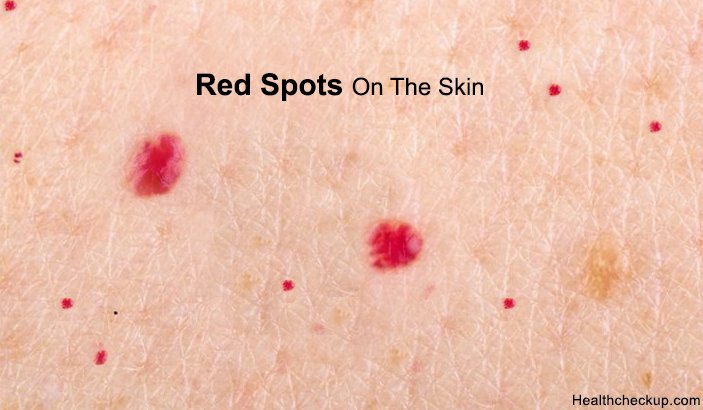Any kind of spots appearing on or beneath skin should raise an alarm to the person. The appearance of such spots is quite often an abnormal finding which may require proper consultation, investigation, and appropriate treatment.
These red spot lesions can occur at any part of the body they may appear in different sizes and can be single at one location or multiple and widespread. These red patches or rashes on the skin may be associated with other symptoms like pain and itching or the affected person can be absolutely asymptomatic.
Skin Lesions Can Basically Be of The Following Types
1. Macule: Flat circumscribed skin lesion less than 1cm in diameter. These may be hypo or hyperpigmented.
2. Patch: Flat circumscribed discoloration of skin more than 1cm in diameter. They can be hypo or hyperpigmented.
3. Papule: Elevated, circumscribed skin lesion less than 1cm in diameter.
4. Nodule: Solid, elevated and circumscribed skin lesion more than 1cm in diameter.
5. Plaque: Solid, elevated skin lesion more than 1 cm in diameter. Its horizontal size is more than vertical size.
6. Vesicle: Circumscribed, elevated skin lesion less than 1cm in diameter containing fluid or blood, but not pus.
7. Pustule: Circumscribed, elevated skin lesion less than 1cm in diameter containing pus.
These above terms will be used further in the article to describe conditions having an appearance of red spots on the skin.
[Read – What Is Allergy Skin Test]
What are The Causes of Red Spots on the Skin?
As already seen above, these red patches can be of different varieties and appearances. Similarly, their causes will also differ. Each variety of rashes is given a specific name for the purpose of understanding and differentiation.
Before describing all the variety of clinical conditions which may cause red spots on the skin, few basic terms for these red spots need to be explained:
| Purpura | Petechiae | Ecchymosis |
|---|---|---|
|
Red-purple discoloration of skin caused by bleeding under the skin. The spots are 0.3-1cm in diameter. |
1-2 mm sized red-purple spots on skin caused due to bleeding under the skin from a ruptured capillary.
|
Sub-cutaneous bleeding more than 1cm in diameter.
The lesion appears similar to bruising. |
Causes:
|
Causes:
|
Causes:
|
Certain skin lesions which begin as red spots and later develop into more complicated skin lesions are also included in the list below along with their causes and their pattern of appearance. Red spots on the skin can sometimes occur since birth.
1. Strawberry Hemangioma
It is also called infantile hemangioma. Characteristic bright red and seen in infants. The spots are absent at birth and increase by about 3 months from birth and resolve in size by 5 years of age without any scar or pigmentation. They appear typically over the face, scalp, back and chest.
2. Salmon Patch
These are red spots over the forehead and head. They last for up to 1-2 years after birth. They are not associated with any disease or deformity and occur due to enlarged capillaries.
3. Port Wine Stain
This type of spot is also called firemark. These irregular, reddish spots on the skin appear due to capillary malformations. The discoloration becomes deeper as age increases.
Other Pathological Causes for Red Spots on Skin are
| Sr. No. | Cause of Red Spots | Description |
|---|---|---|
| 1 | Rosacea | It is an inflammatory condition often seen on the face, especially cheeks and nose. There is redness of face and flushing. This condition is often understood for acne or sunburn. |
| 2 | Cherry Angioma | These are tine, red moles on the skin. They vary in size and location. Formation of new blood vessels causes cheery angioma. They are harmless red spots on the skin usually seen in the elderly. |
| 3 | Insect Bites | Lesions due to insect bites are red bumpy spots with itching. Red spots due to insect bites usually resolve within 2-3 days without any treatment. Severe symptoms like difficulty in breathing and fever along with the red bumpy spots must not be ignored. |
| 4 | Urticaria | It is a type of hypersensitivity or allergic reaction. The rashes are ill-defined, raised and itchy red spots. The rash tends to flare up suddenly and lasts for about 4-5 hours. There may be associated swelling with skin lesions. Identification of triggering agent is essential. |
| 5 | Allergic Purpura | Red spots beneath the skin of varying sizes. The skin spots may appear like bruises after taking certain medications. |
| 6 | Pityriasis Rosea | Itchy, red patches are caused due to a virus belonging to the herpes virus group. It affects children and young adults more commonly. Lesions are itchy, red plaques which may be slightly elevated. Covered parts of the body are typically affected. |
| 7 | Erythema Multiforme | Young adults are commonly affected. Lesions, as the name suggests are multi-form. Skin lesions begin as itchy red macules (spots) and later become papules and plaques. They are called “bull’s eye” lesion or “iris: lesions. It commonly affects lips, mouth, genitals, plasma and soles and trunk. |
| 8 | Measles | It is a highly contagious infection caused by rubeola virus. “Koplik’s spots” in the mouth are diagnostic of measles. A macular-papular rash begins at the trunk and spreads all over the body. |
| 9 | Chickenpox | This is the most common viral infection. It is contagious. Skin lesions are itchy. They start as red macules and develop into papules and vesicles in a few days. They are later covered by crusts. Each crop of eruptions is associated with fever. |
| 10 | Herpes Zoster/ Shingles | It is a viral infection that commonly affects adults. Initial lesions are red macules, papules and vesicles along a nerve segment distribution. Lesions appear as multiple rashes in a group. Skin lesions contain blood or pus. The trunk or extremities are the most common sites. |
| 11 | Scabies | These are tiny red papules over finger, wrists and web-spaces between fingers. These are commonly seen in infants and young children. Presence of a “burrow” is diagnostic of scabies. |
| 12 | Tinea corporis | It is a fungal infection of the skin caused by “dermatophyte”. It occurs typically on arms and legs but may be present on any part of the body and It’s contagious in nature. |
| 13 | Psoriasis | It is a chronic skin condition. Plenty of environmental, hereditary and immune factors are responsible for the development of psoriasis. It can affect any part of the body.
Red, itchy spots on skin without much elevation and covered by a whitish crust. Multiple papules may join to form a large plaque. Koebner’s phenomenon and Auspitz sign are diagnostic. |
| 14 | Nummular Dermatitis | It is a chronic skin condition. Characteristic coin-shaped red skin lesions typically present on arms and legs which last for weeks to months.
These red, itchy patches occur usually after burns, insect bites or skin injury. |
| 15 | Impetigo | It is a bacterial infection of the skin caused by Staphylococcus and Streptococcus.
Most common sites face and around the nose. Lesions begin as macules and change to pustules. Lesions have typical yellow-brown crusts over them. |
| 16 | Steven’s Johnson Syndrome | It is a rare and a very serious skin rash which appears after administration of certain drugs. It commonly affects adolescents and young adults.
Skin lesions are red, tender and itchy spots which later transform into dark-red or dark-brown. The edges of skin lesions remain itchy and red. |
Red Spots on Skin can also Appear as A part of Some other Underlying disease Process. These Clinical Conditions are
- Systemic Lupus Erythematosus
Red patches or red spots on the skin due to systemic lupus erythematosus can be of the following types
● Discoid Lesions – Red, itchy round spots, and plaques with de-pigmented centers. Adherent scales are present. Nose, forehead, scalp and around ears the most common sites.
● Facial Erythema – This is also called the “butterfly rash” which is a typical sign of SLE. Bright red discoloration of the skin over the nose and cheeks. - Vasculitis
An auto-immune inflammatory process resulting in occlusion or obstruction of blood vessels is called vasculitis. Purpuric papules can be seen in small vessel vasculitis. These can also develop into plaques. - Erythema Nodosum
This is a hypersensitivity response to a variety of irritants, chemicals, infections, and medications. It can also be seen in presence of auto-immune diseases. Skin lesions are red, painful and elevated nodules about 1-10cm in diameter. The nodules turn brown-red while subsiding without leaving any scar. - Salmonella Typhi
A patient having salmonella infection often develops rose-red spots. These are about 2-4 mm in diameter and are seen commonly over the trunk region. The rash appears from 7-12th day of infections.
[Read – Things Responsible For Skin Tags on Tongue]
How to Get Rid of the Red Spots on Skin?
Each cause of red spots on the skin will require the patient to be investigated and treated using a specific line of treatment.
Most of the red spots on the skin will diminish without much effort. Some may, however, persist even after the disease condition has been cured.
- Skin lightening creams when used regularly can help to diminish the red spots.
- Flash lamp therapy encourages new collagen growth of the skin. As new skin appears, the spotted skin goes away naturally.
- Skin exfoliating agents can help in naturally exfoliating the pigmented portion of the skin to give rise to the newer normal skin.
Your dermatologist or physician may be well aware of these above therapies and they usually recommend these since pigmented skin can cause considerable embarrassment.
Home Remedies to Remove Red Spots On Skin
Treating the cause is an important factor in approach towards these patients. That’s why it is important to undergo proper medical consultation and advice before resorting to home remedies because some of the home remedies may worsen your actual skin condition.
Natural Home Remedies to Remove Red Spots from The Skin are
- Coconut Water – This remedy has been used since ages to remove chicken pox or measles marks and reduce red spots too. Coconut water is anti-microbial and rich in electrolytes and lauric acid. These qualities work wonders for the skin.
- Coconut Oil – It has natural anti-bacterial and anti-fungal properties.
- Ice – Applying ice to affected parts reduces inflammation.
- Lemon juice – Lemon juice has natural bleaching properties. It shouldn’t be applied without dilution though as it may sting.
- Aloe Vera Gel – Apply fresh aloe vera gel. Keep it for 15-20 minutes and rinse it off. A routine application of this reduced spots and scars and makes the skin fresh. Aloe vera also soothes and heals wounds and cuts.
- Tomato – Tomato juice has natural astringent properties. It cleanses the skin and reduces irritation on the skin.
- Apple Cider Vinegar – As a rule, do not use this undiluted. ACV is an excellent home remedy for a wide range of clinical conditions. ACV is anti-bacterial and immediately reduced inflammation and skin irritation.
- Baking Soda – Make a soft paste by mixing baking soda with some water. Apply on to the affected part and rinse off. It reduces red spots as well as scars and marks.
- Garlic – This has anti-infective properties due to its high sulfur content. Apply garlic over the red spots and rinse off after 10 minutes.
- Egg White – Beat the egg white till it is foamy and apply this as a mask to the affected part. Egg-white reduces inflammation and also removes red spots and marks naturally.
It is highly recommended to seek professional help before using any of these home remedies. These home remedies should not be used as a substitute for your normal treatment.
Medically Reviewed By
Dr. Himanshi is a Homoeopathic consultant and currently working as a lecturer in Post-graduate faculty of Homeopathy, Parul University, Vadodara. Completed BHMS and MD in Homeopathy in January 2018 and also has a clinical experience of about 6 years. Personal interests include reading, spending time with family and traveling.








